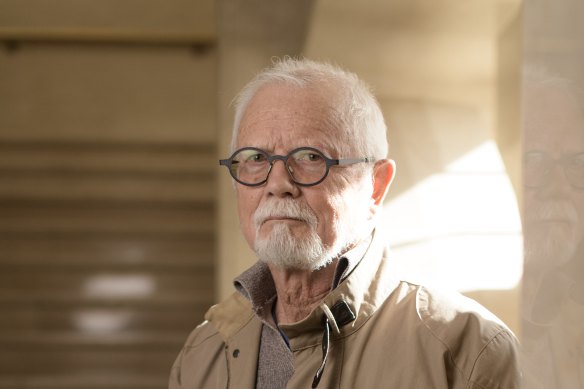

Rodney Hall’s Vortex is possibly his most ambitious work.
FICTION
Vortex
Rodney Hall
Picador, $34.99
At the age of 88, Rodney Hall’s new novel, Vortex – his 14th work of fiction – is perhaps his most formally ambitious work to date. From his 1972 novel The Ship on the Coin to his Miles Franklin-winning Just Relations (1982) and The Grisly Wife (1993), Hall has never been easy to categorise, pushing and twisting the novel form with each new work. As he writes in The Island of the Mind (1996), “We are the inheritors of a world we need to remake for ourselves.”
Because of its formal experimentation, Vortex presents innumerable problems for the book reviewer who is bent on providing the reader with an appropriate summary. On the surface, the novel is centred around Queen Elizabeth’s visit to Brisbane in 1954. The novel begins on the Queen’s “royal yacht Gothic” as “life alters course around her”. However, by the end of the paragraph, she has been de-centred by the vast forces of nature around her, summoned as if “on a writhing spool of ghostly energy”. From this spool of loose, ghostly threads, Hall gives us history (and fiction) as both vortex and web, a swirling yet entrapping series of fragments.
Although the novel is fragmentary – each chapter and in-chapter section starts mid-sentence – it is never pure anarchy. The vortex and web, as structuring principles, are dialectically productive, rather than self-cancelling. A vortex is contrapuntal, always moving and non-discriminatory, drawing “every last scrap into its force field”; a web, in contrast, is static, an attempt to cohere and connect vast fragments with some kind of order. Both are metaphors of entrapment and death, if you happened to get caught or sucked into one. Hall resists this by moving in and out of both modes, never letting one predominate.
Emblematic of this structure is the panorama of characters that we encounter, most of whom congregate at the Colony Club, a place for exiles hosted by the Countess Paloma Claverhouse. Most of these characters have been flung into Australia by the vortex of World War II, and are reduced now to telling stories as a way of keeping their memories alive. As Paloma tells them, “It’s up to us, you know, to piece together the fragments.”
Alongside these characters, the second chapter gives us what we might initially take to be the protagonist, Compton Gillespie, a 16-year-old boy – similar in age to Hall in 1954 – who has dropped out of school after his mother is confined to a hospital bed. His arc – to the extent that it is an arc – is a classic coming-of-age narrative, as he is initiated into the vagaries of life by the enigmatic German emigre, Beckmann. However, thinking of Compton as the protagonist would be making a false assumption; the novel refuses that kind of coherence, even if the reader might place it with Compton or with another character. Various characters also make this mistake as they seek some centralising meaning and coherence.

Rodney Hall’s Vortex initially centres on Queen Elizabeth’s 1954 visit but alters course.Credit: Wolter Peeters
Take, for instance, the exiled Tsarist loyalist, Vassily Bogdanovich Hmelnitsky, now a vagrant roaming the Brisbane streets, who “can always resurrect the old hero: himself the central figure around whom the fragments of chaos cohere in scribblings as silent as a snowstorm”. Even Compton’s “hero”, Beckmann, tells him that Wolfgang Borchert – a real author – based the protagonist of his play The Man Outside on Beckmann, although all we really know is that they share the same name.
Rather than finding meaning in a central character, Hall invites us to take up meaning wherever we may find it. This echoes the invitation that adorns the novel, the epigraph from Mikhail Bakhtin: “We ourselves may enter the novel.” For Hall, the novelist’s duty – to the extent that they have one – is reflective of what Beckmann says about Wolfgang Borchert’s resistance to Hitler: “His stories said no.” The danger of this stance is a potentially weary didacticism. Hall, in this novel and throughout his career, elides such a didacticism with his commitment to style above all else.









 Add Category
Add Category